Our Top 20 Articles of 2016
In 2016 Aerossurance’s digest of aviation and safety articles attracted twice as many readers as in 2015. As we prepare to start a new year we look back on the 10 most read articles in 2016 from the choice of over 400 on our website.
In reverse order:
Number 10: Retreating Blade Stall Incident
During a patient transfer in Australia, an Emergency Medical Service Airbus Helicopters BK 117 dropped 4,000 ft after a loss of control in the cruise.
No injuries were reported and the helicopter sustained minor damage the horizontal stabiliser end plates. These were struck by the main rotor blades, which themselves were undamaged. The Australian Transport Safety Bureau (ATSB) investigation report highlights the phenomena of retreating blade stall:
The selected cruise speed of 115 kt was close to the calculated never exceed speed (VNE) for the conditions of 120 kt. In combination, the high all-up weight and speed required greater collective pitch, or main rotor blade angle. This placed the blades closer to their stalling angle of attack.
The cruise altitude of 5,000 ft resulted in operation at a moderately high density altitude and in areas of moderate turbulence. These conditions, coupled with the effect of the already-discussed high all-up weight are known to be conducive to the onset of retreating blade stall at high speed. The uncommanded nose-up pitch and subsequent roll in the direction of the retreating blade indicated that retreating blade stall took place.
Number 9: Fatigued Flight Test Crew Crosswind Accident
The Icelandic Transportation Safety Board (ITSB), the RNSA, issued their report into a wheels up runway excursion accident that occurred on 21 July 2013 to Sukhoi RRJ-95B ‘Superjet 100’ 97005 during flight tests by Sukhoi at Keflavik airport.
The RNSA concluded “that human factors played a significant role in this accident”. In particular significant fatigue was evident.
Number 8: Fatal Wire Strike on Take Off from Communications Site
The Transportation Safety Board of Canada (TSB) released their report on Airbus Helicopters AS350BA C-GBPS, operated by Canadian Helicopters (CHL), that departed a microwave communication site and fatally struck one of the microwave tower guy wires.
The lack of effective risk assessment and landing site data jumps out in their report as does a casual approach to some pre-flight preparation. There are key survivability lessons too.
Number 7: Critical Maintenance Tasks: EASA Part-M & -145 Change
This article discussed Commission Regulation (EU) 2015/1536 . One of the most important parts of the change relates to Critical Maintenance Tasks (CMTs), which are defined as:
…a maintenance task that involves the assembly or any disturbance of a system or any part on an aircraft, engine or propeller that, if an error occurred during its performance, could directly endanger the flight safety.
The European Aviation Safety Agency (EASA) has said that this change:
…addresses a safety issue related to the risk of errors made during the performance of critical maintenance tasks and the need for maintenance organisations to implement methods to capture those errors before the certificate of release to service is issued.
The NPA was in part prompted by following three safety recommendations addressed to the Agency:
- AIBN recommendation 12/2006, Report on the aircraft accident at Bergen Airport Flesland, Norway, on 31 January 2005 involving ATR 42-320, OY-JRJ, operated by Danish Air Transport, when control problems were experienced an elevator bolts loosened and fell out. The self-locking nuts were not tightened with the required torque.
- UK AAIB Safety Recommendation 2005-123 in Report 3/2005 on the serious incident to Boeing 757-236, operated by British Airways, on 7 September 2003. Maintenance errors that had culminated in the failure to reinstall two access panels on the right-hand outboard flap and incorrect engine oil top up.
- UK AAIB Safety Recommendation 2006-030 AAIB Bulletin: 11/2006 EW/C 2004/10/03 on the fatal accident to a privately operated Mooney Aircraft Corporation M20J, G-EKMW. A defect was discovered within the engine’s dual magneto, which had recently been refitted following a 500 hour inspection, affecting both ignition systems. This led to a loss of power shortly after take off and the aircraft impacting the ground while attempting to return to the airfield.
Number 6: ANSV Issue AW609 Tilt Rotor Accident Investigation Update
The Italian civil aviation safety investigation authority, the Agenzia Nazionale per la Sicurezza del Volo (ANSV), issued an interim statement of the loss of prototype #2 (AC2) Leonardo AW609 tilt rotor N609AG in Italy on 30 October 2015.
The aircraft was on the third run during that test flight to the maximum dive speed of 293 KIAS (on previous flights the highest test point was 285 KIAS). Investigators say a prototype tilt rotor broke up in flight after a divergent dutch roll developed. bpth test pilots aboard lost their lives.
Number 5: HEMS Black Hole Accident: “Organisational, Regulatory and Oversight Deficiencies”
The Transportation Safety Board of Canada (TSB) issued their report into a fatal night-time Controlled Flight Into Terrain (CFIT) accident that destroyed Sikorsky S-76A helicopter C-GIMY, operated Ornge. All 4 onboard died.

Depiction of C-GIMY’s Descent (Credit: TSB)
The accident occurred during a Helicopter Emergency Medical Service (HEMS) departure in ‘black-hole’ conditions. These conditions “typically occur over water or over dark, featureless terrain where the only visual stimuli are lights located on and/or near the airport or landing zone”.
The TSB said the operator had insufficient resources to effectively manage safety. The regulator, Transport Canada, had concerns but…
…the approach to returning the operator to a state of compliance was not well matched to the capabilities of the operator.
Number 4: ATR 72 In-Flight Pitch Disconnect and Structural Failure
On 15 June 2016 the Australian Transport Safety Bureau (ATSB) issued an Interim Report on a serious incident with a Virgin Australia Regional Airlines (VARA, formerly Perth, WA based SkyWest) ATR 72, registered VH-FVR. While operating a scheduled passenger flight from Canberra to Sydney the aircraft sustained a pitch disconnect on final descent.
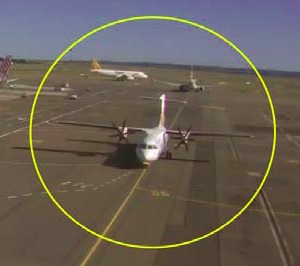
ATR72 VH-FVR taxiing inbound at Sydney on 20 Feb 2014 following the in-flight pitch disconnect (still image from CCTV). Note angle of the horizontal stabiliser relative to the wings. (Credit: via ATSB)
Significant structural damage occurs when crew make opposing pitch inputs say ATSB.
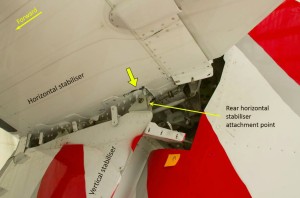
Horizontal-to-vertical stabiliser attachment with the aerodynamic fairings removed. View looking upwards at the underside of the horizontal stabiliser. The thick yellow arrow indicates cracking in the composite structure around the rear attachment point (Credit: ATSB)
The damage was also missed for 13 subsequent flights. The ATSB have slipped the estimated date for the final report to March 2017.
Number 3: Final Report: AS365N3 9M-IGB Fatal Accident
The Malaysian Air Accident Investigation Bureau (AAIB) has issued their final report on the accident to a privately operated Airbus Helicopters AS356N3 Dauphin 9M-IGM on 4 April 2015. The helicopter was carrying VIPs from a wedding luncheon. While in the cruise, the helicopter, with 6 persons on board was seen to dive into the ground. There were no survivors.
The investigators concluded:
The cause of the accident was due to the separation of the left horizontal stabiliser in flight causing the helicopter to dive and bank to the right exceeding its flight envelope.
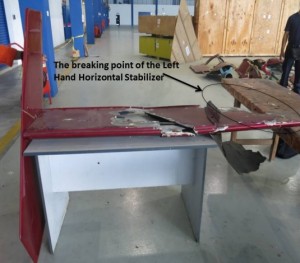
Right Hand Horizontal Stabiliser AS365N3 9M-IGB Showing Were the Left Hand Side had Departed (Credit: AAIB)
The stabiliser had been damaged when the aircraft had sunk into soft ground during its previous landing. That was an impromptu stop to disembark one passenger due to apparent pressure from the client onboard.
Number 2: Dramatic Malaysian S-76C 2013 Ditching Video
This second Malaysian helicopter accident made Number 2, down from Number 1 in 2015.
Dramatic and unique passenger-shot video footage of a helicopter ditching next to a seismic ship and the subsequent rescue off Malaysia. The Sikorsky S-76C 9M-STE (MSN 760398) of MHS Aviation, chartered by Malaysian oil and gas company Petronas, was on approach to a 3D seismic ship in the South China Sea on 12 December 2013.
Not only does our article it feature a dramatic video but ditching survivability is a highly topical safety issue of public interest.
Fortuitously everyone on-board survived and the survey ship Viking Vision sent a boat back to pick them up.
An estimate of when the official accident investigation report is due has slipped (again) to January 2017.
And the top story of the year:
Number 1: EC225 Main Rotor Head and Main Gear Box Design
Following the tragic accident at Turøy near Bergen, Norway on 29 April 2016 involving EC225/H225 LN-OJF there was a lot of interest in the Main Rotor (MR) and Main Gear Box (MGB) design of the EC225, and subsequently the AS332L2.
While making a return flight to Bergen-Flesland Airport, Norway from the Statoil Gullfaks B offshore installation, the CHC helicopter broke up in flight. The 13 people on board died in the accident. This popular article provide some background information on the design.
We also expanded on the Accident Investigation Board Norway (AIBN) investigation and regulatory developments (from EASA, the FAA, the Luftfartstilsynet and the UK CAA) as they happened in: EC225 LN-OJF Accident Investigation Timeline (our 11th most popular article of 2016).




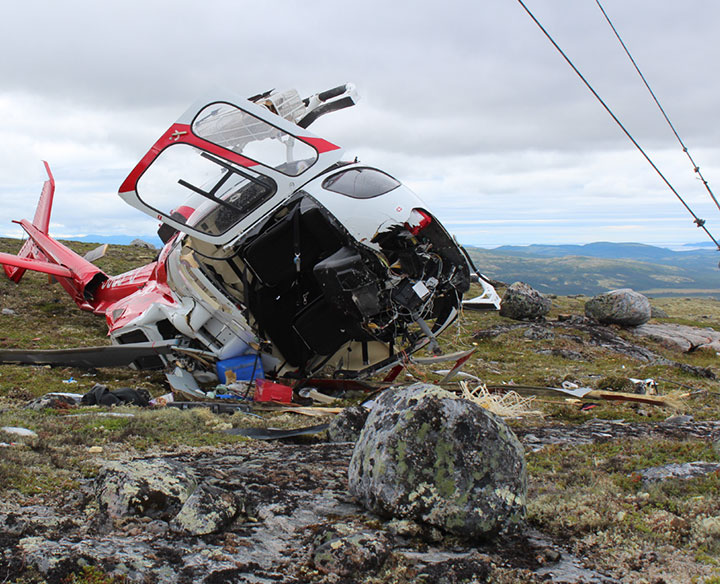
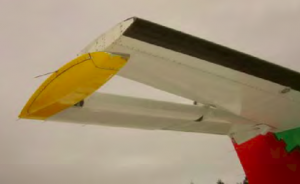




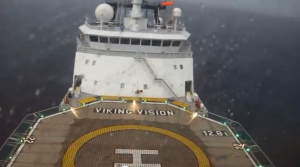

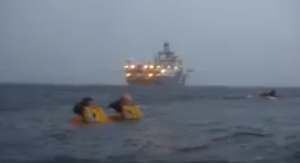
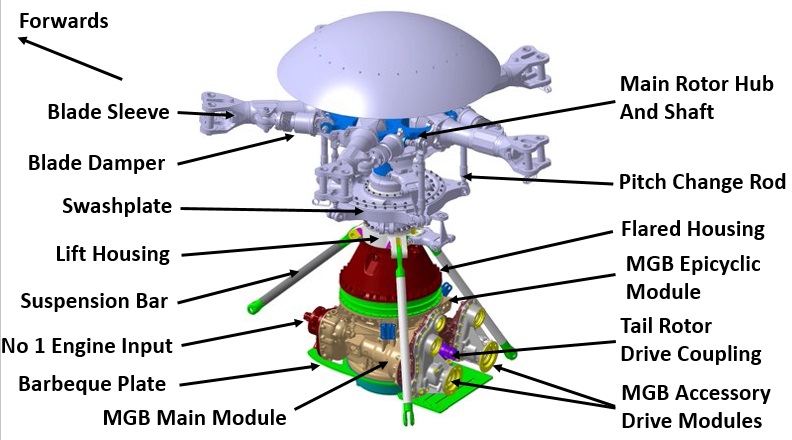
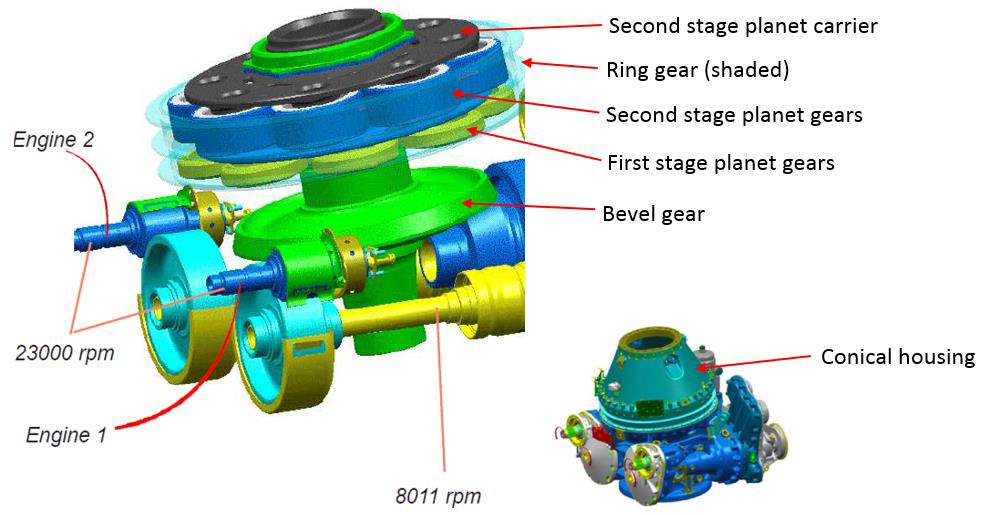

Recent Comments